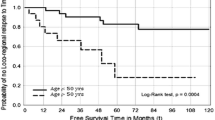Abstract
The aim of this study is to evaluate the quality of life (QoL) of nasopharyngeal carcinoma (NPC) survivors. 192 NPC survivors treated in 1999 and 2000 were enrolled in this study. Median follow up was 3.6 years (range 2.4–4.6 years). The Chinese SF-36 questionnaire and a self-reported symptom checklist consisting of 14 items were completed at clinics. Sociodemographic factors and clinical information were also collected. Most functional domains of the Chinese SF-36 were significantly worse in NPC survivors compared to the normal population. Xerostomia, hearing loss, hypomnesia, dysphagia, and trismus were frequently reported symptoms. Sociodemographic variables including gender, age, dialect, educational level, monthly income, economic status, and number of comorbidities were univariate predictors of different SF-36 domains and symptoms. Patients with earlier T and N stage, irradiated by linear accelerator, with lower dose and weekly dose to nasopharynx and neck, and those who had anterior nasal radiation field reported better QoL. Multiple stepwise regression analysis showed that the number of comorbidities, monthly income, age, and T stage were independent factors affecting global QoL. We concluded that NPC survivors had worse QoL than the normal population and improving radiotherapy might increase physical and functional domain of QoL.
Similar content being viewed by others
Abbreviations
- Gy:
-
Gray
- 3D-CRT:
-
Three-dimensional conformal radiotherapy
- IMRT:
-
Intensity-modulated radiotherapy
- 60Co:
-
Cobalt-60
References
Parkin DM, Muir CS, Whelan SL, et al (1992) Cancer Incidence in Five Continents, vol VI. IARC Science Publications, Lyon, p 120
Huang TB, Min HQ (1998) Epidemiology of nasopharyngeal carcinoma. In: Min HQ, Wang HM, Zhang EP, et al. (eds) Nasopharyngeal Carcinoma Research. Guangdong Science and Technology Press, Guangzhou, pp. 6–12
Ma J, Mai HQ, Hong MH, et al (2001) Is the 1997 AJCC stage system for NPC prognostically useful for Chinese patient populations?. Int J Radiat Oncol Biol Phys 50:1181–1189
Scott CB, Stetz J, Bruner DW, et al (1994) Radiation Therapy Oncology Group quality of life assessment: Design, analysis, and data management issues. Qual Life Res 3:199–206
Fallowfield L (2002) Quality of life: A new perspective for cancer patients. Nat Rev Cancer 2:873–879
Zeng YX, Jia WH (2002) Familial nasopharyngeal carcinoma. Semin Cancer Biol 12:443–450
Shanmugaratnam K, Sobin LH (1991) International histologic classification: Histologic typing of tumors of the upper respiratory tract and ear. 2nd ed. Springer-Verlag, Berlin, pp 32–33
Min H, Hong M, Ma J, et al (1994) A new staging system for nasopharyngeal carcinoma in China. Int J Radiat Oncol Biol Phys 30:1037–1042
Hong MH, Mai HQ, Min HQ, et al (2000) A comparison of the Chinese 1992 and fifth-edition. International Union Against Cancer staging systems for staging nasopharyngeal carcinoma. Cancer 89:242–247
Chinese edition of SF-36. In: Fang JQ (ed), Measurement and Application of Quality of Life. Beijing: Beijing University of Medical Sciences Press, 2000: 263–294
Osoba D (1993) Self-rating symptom checklists: A simple method for recording and evaluating symptom control in oncology. Cancer Treat Rev 19(Suppl A):43–51
Ware JE Jr, Kosinski M, Keller SD (1994) SF-36 Physical and Mental Health Summary Scales: A User’s Manual. The Health Institute, New England Medical Center, Boston
Nunnally JC (1978) Psychometric Theory. 2nd ed. McGraw-Hill, New York, pp. 45–51
Li NX, Liu CJ, Li J, et al (2001) The norms of SF-36 scale scores in urban and rural residents of Sichuan Province. Hua Xi Yi Ke Da Xue Xue Bao 32:43–47
Zee BC, Osoba D. Health-related quality of life outcome, In: Crowley J (ed), Handbook of Statistics in Clinical Oncology. Marcel Dekker, 2001: 249–267
Fang FM, Chiu HC, Kuo WR, et al (2002) Health-related quality of life for nasopharyngeal carcinoma patients with cancer-free survival after treatment. Int J Radiat Oncol Biol Phys 53:959–968
Calman KC (1984) Quality of life in cancer patients — an hypothesis. J Med Ethics 10:124–127
Kian AK, Thames HD (2004) Altered fractionations schedules. In: Perez CA, Brady LW, Halperin EC, et al, (eds) Principle and Practice of Radiation Oncology. 4rd ed. Lippincott Williams & Wilkins, Philadelphia, pp. 337–356
Denham JW, Peters LJ, Johansen J, et al (1999) Do acute mucosal reactions lead to consequential late reactions in patients with head and neck cancer? Radiother Oncol 52:157–164
Hammerlid E, Mercke C, Sullivan M, et al (1997) A prospective quality of life study of patients with oral or pharyngeal carcinoma treated with external beam irradiation with or without brachytherapy. Oral Oncol 33:189–196
Lin A, Kim HM, Terrell JE, et al (2003) Quality of life after parotid-sparing IMRT for head-and-neck cancer. Int J Radiat Oncol Biol Phys 57:61–70
Parliament MB, Scrimger RA, Anderson SG, et al (2004) Preservation of oral health-related quality of life and salivary flow rates after inverse-planned intensity-modulated radiotherapy (IMRT) for head-and-neck cancer. Int J Radiat Oncol Biol Phys 58:663–673
Acknowledgments
The authors would like to thank Mr Yan-Fu Zhou, Mr Mu Chen, Mr Ke-Jie Wu, Mr Jin-Yu Chen, Mr Yu-Jun Li and Mr Zhan-Qiang Zhang for their assistance with data collection and processing, Ms Amy Hamilton, Mr Jian-Qiang Feng and Mr Guan-Heng Hu for their assistance in English editing.
Author information
Authors and Affiliations
Corresponding author
Rights and permissions
About this article
Cite this article
Wu, Y., Hu, WH., Xia, YF. et al. Quality of life of nasopharyngeal carcinoma survivors in Mainland China. Qual Life Res 16, 65–74 (2007). https://doi.org/10.1007/s11136-006-9113-0
Received:
Accepted:
Published:
Issue Date:
DOI: https://doi.org/10.1007/s11136-006-9113-0



